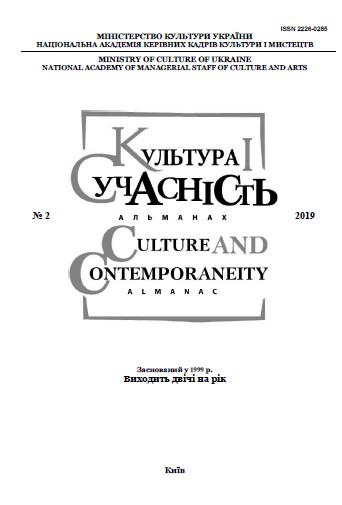ОСОБЛИВОСТІ ПРОГРАМНОГО СИМФОНІЗМУ 1990-х РОКІВ У СУЧАСНІЙ КИТАЙСЬКІЙ КОМПОЗИТОРСЬКІЙ ТРАДИЦІЇ НА ПРИКЛАДІ «П’ЯТИ СТИХІЙ» (“WU XING”, “LES CINQ ÉLÉMENTS”) ДЛЯ СИМФОНІЧНОГО ОРКЕСТРУ ЦИГАНА ЧЕНЯ
PARTICULARITIES OF PROGRAM SYMPHONIC STYLE OF THE 1990S IN THE CONTEMPORARY CHINESE COMPOSING TRADITION, CASE STUDY: “WU XING” (“LES CINQ ÉLÉMENTS”) FOR QIGANG CHEN’S SYMPHONIC ORCHESTRA
Author(s): Cheng YunjiaSubject(s): Cultural history, Music, Transformation Period (1990 - 2010), History of Art
Published by: Національна академія керівних кадрів культури і мистецтв
Keywords: symphonic program style; monothematic technique; concert principle; isometric motet principle; legitimate of wave “whitecaps”; repriseness; rhetoric figure passus duriusculus; clustering;
Summary/Abstract: Purpose of the article. This article has the purpose of outlining systemic features of symphonic program style as a method of artistic thinking and national particularities of Chinese symphonic music for a European orchestra. The methodology envisages the use of the holistic, systematic, comparative, and historical methods of musical analysis. The scientific novelty of research results stems from the fact that the author is the first scholar who introduced to Ukrainian scientific overview a work from the realm of Chinese program symphonic style and defined the degree of transformation of national tradition and innovativeness of Qigang Chen’s music style. Conclusions. Qigang Chen’s “Les Cinq Éléments” is a vivid example of Chinese program symphonic style of the 1990s, which manifests itself in cyclicality, conception methods and polyphonic type of development in a quite small format, audiovisual nature and characteristic approaches in orchestration, addressing the timbres of Chinese folk instruments flute and erhu, poem principle, concert principle, style allusions with the baroque era by addressing rhetoric figures as the carriers of heightened emotional effect of music on the listener, free use of modern composing techniques, and dilution of the notions of “tonality” and “theory of functions” in the regular classical romantic system.
Journal: Культура і сучасність
- Issue Year: 2019
- Issue No: 2
- Page Range: 216-221
- Page Count: 6
- Language: Ukrainian

